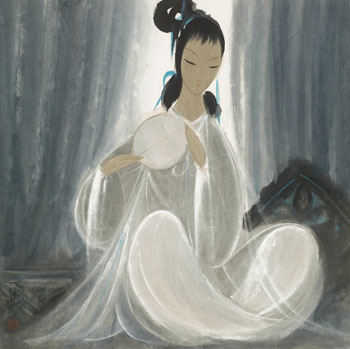EXHIBITED:
Peerless Grace - Hangzhou National Academy of Fine Arts, Tina Keng Gallery, Taipei, Taiwan, March 6-28, 2010
ILLUSTRATED:
History of One-Hundred-Year Chinese Oil Paintings: The Great Epic of Art in 20th Century, Artist Publishing Co., Taipei, 2002, color illustrated, p. 583
Catalogue Note:
Known as the “father of modern Chinese painting,” Lin Fengmian’s prodigious career has been celebrated the world over for elevating and promoting a uniquely Chinese Modern Art movement. By introducing elements of Western aesthetics to art with traditional Chinese elements and themes, Lin Fengmian’s work has been widely sought by discerning collectors.
Considered a child prodigy, Lin traveled to France at only 20 years old to study at the École nationale supérieure des Beaux-Arts in Paris. Returning to China in 1926, Lin quickly established himself as the director of the National Beijing Fine Art School, and by the time he was 29 years old, he had become president of the Hangzhou National College of Art, which later evolved into the prestigious China Academy of Art. Urging his students to explore originality and innovation, Lin called for a promotion of new and modern arts in China, claiming, “Development of national culture comes from the creation of a new era by the absorption of other cultures while basing upon one’s own.” As such, Lin encouraged his students and fellow artists to examine the properties of Western art movements to incorporate new elements into Modern Chinese art. Over the course of the next few decades, however, Lin suffered persecution and destruction at the hands of warring parties and his own Chinese government. In the late 1930s, during the second Sino-Japanese War, soldiers ransacked Lin’s home, ruining many of his paintings in the process. Several decades later in 1966, Lin himself destroyed more than 2,000 of his colored ink paintings, soaking them in water until the delicate paper turned to unrecognizable pulp, in an effort to protect his friends and family from the violent fervor of the Red Guard’s wrath against traditional art and values.
Dated 1961, Lady Holding a Fan serves as a stunning example Lin Fengmian’s work in the early 60s. Arresting in its serene beauty, the present lot exhibits Lin’s European influences in combination with a traditional Chinese subject and aesthetic. With inspiration from Fauvism, the deep, rich colors in Lady Holding a Fan recall the delineation of two-dimensional space often found in works by masters such as Henri Matisse, with the central subject depicted with the elegance and elongation of Modigliani’s lithe figures. Lin utilizes these Western Modernist elements in confluence with the soft translucency of traditional Chinese ceramic arts, specifically Song Dynasty Guan Yao and Long Quan porcelain. With an expert application of line and color, in this painting Lin establishes a luminescent serenity replete with classical grace and refinement. Deftly utilizing fine and balanced lines to establish the central figure, the delicate brushstrokes demonstrate Lin’s meticulous attention to the complexity of the scene. “What we can pay attention to, while speaking of lines, ” explains Lin, “is ‘the line of gracefulness and liveliness’.
Curved and straight lines are in opposition, the latter is tranquil and peaceful, which is also a manifestation of continual balance.” Such harmony in the combined usage of both curved and straight lines is readily apparent in Lady Holding a Fan, as gentle arcs interact symphonically with geometric angles to establish space and form. Lin’s singular layering of fine and graceful white lines and transparent white over heavier deposits of darker paint creates a gauzy radiance, illuminating the entire composition. A striking example of the artist’s mastery of line, color, and form, the present lot offers an exceptional construction by this master of Modern Chinese art.
Continually seeking to elevate Chinese art through the introduction of international influences, Lin Fengmian laid the foundation for almost a century of development and innovation for artists in China.
Believing in the universality of art, Lin once stated, “As a matter of fact, the shortcomings of Western Arts are exactly where the strengths of Eastern Arts lie, and the strengths of Western Arts are also where the shortcomings of Easter Arts lie. Complementing each other produces the world’s new arts.”
